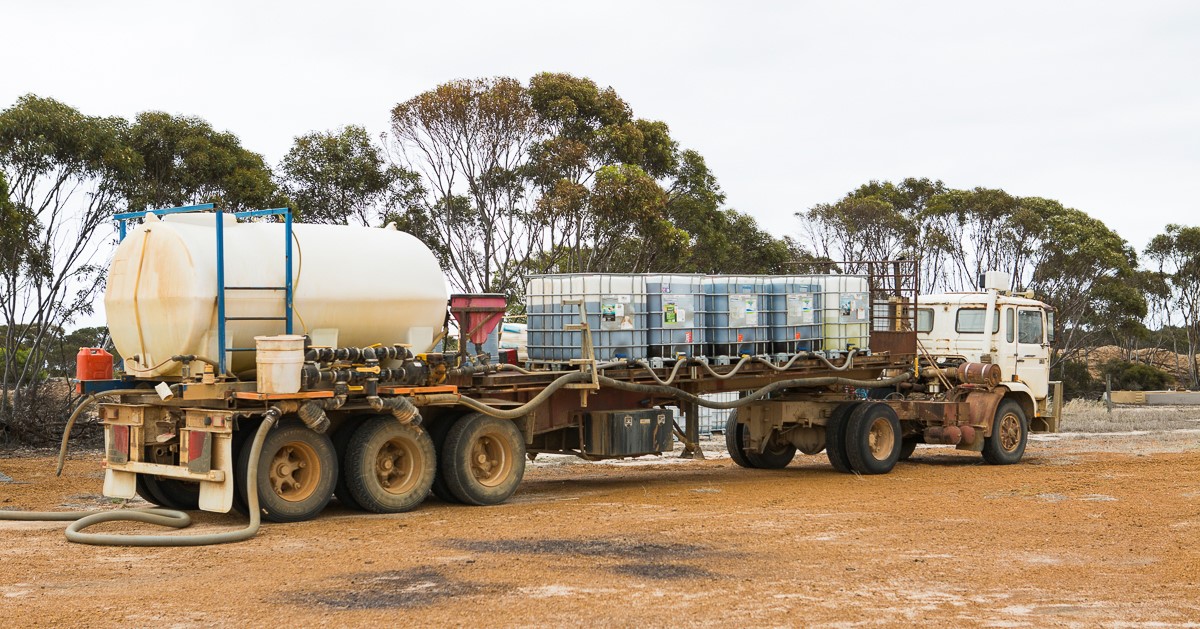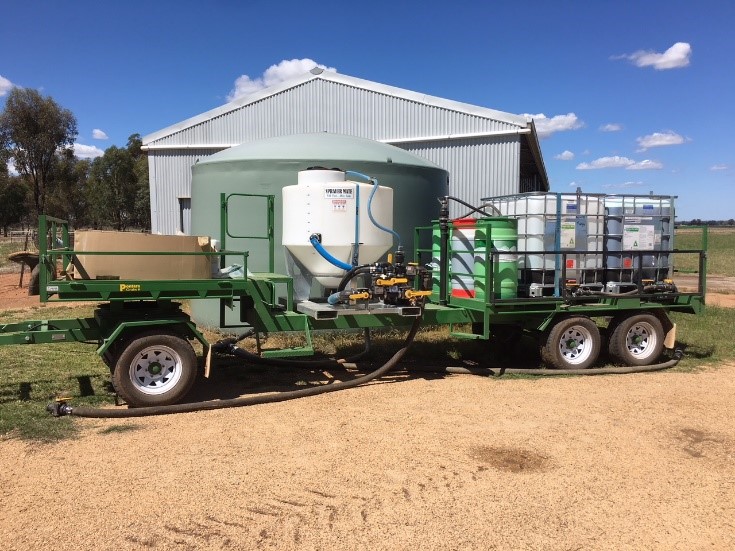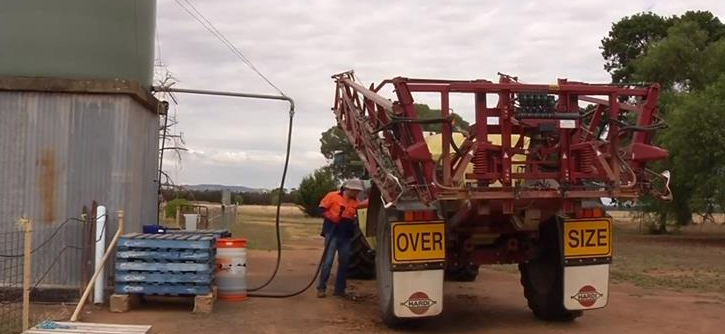The efficiency of refilling operations can have a major impact on the cost-effectiveness of spraying as well as the lifespan of the spray machinery.
The ability to maximise the area sprayed in a day is determined by:
- how efficiently the sprayer can be filled
- the time taken getting to and from the paddock
- the operation of the sprayer itself – ground speed, opening/closing of boom.
Spraying hours are mostly limited due to meteorological conditions specified on the product labels. This includes surface temperature inversions, high wind speed, frosts, heat and rain.
Growers want to maximise the hectares sprayed with the available time and labour and the ways to achieve this will vary from operation to operation.
Making spraying as efficient as possible has the twin benefits of increasing the likelihood of better control through better timing of application which in turn leads to lower costs.
Increasing travel speed can increase the area sprayed per day, however this introduces problems such as:
- increasing the potential for spray drift via updraft behind the boom.
- increasing wear on the machine, particularly the boom and drive system.
- reducing spray coverage. Boom auto-height improves spray deposition and helps protect the boom but does not fully overcome updrafts behind the machine.
Other methods for increasing spray efficiency may pose fewer issues regarding spray effectiveness and drift.
Increase hectares per load
To increase the area sprayed per load, the options are to reduce application volume per hectare and/or increase tank size.
Reducing application volume requires a good understanding of the different products being used – how they work (mode of action), the target weeds, the effect of meteorological conditions and the spray quality being used. Lower water volumes with large droplets (less than 70 litres per hectare) may only suit the use of highly water soluble pre-emergent herbicides in low levels of stubble, or translocated herbicides such as 2,4-D as per the APVMA guidelines ( https://apvma.gov.au/node/15581 ) on moderate to larger target weeds.
Products that require good to excellent coverage or which are not well translocated, such as herbicides from groups A, C, D, F, G, H and L, as well as fungicides and some insecticides, require higher water volumes (80 to 100-plus L/ha). These require 10 to 20 per cent coverage, which can be checked using water sensitive paper and the SnapCard® app ( https://www.agric.wa.gov.au/grains/snapcard-spray-app ) or fluorescent dye and UV lights.
A larger spray tank is another way to improve the area sprayed per day as it reduces the number of fills per day. However, this can affect the stability of the spray unit. Paddock evenness and soil type such as loose sand or heavily ploughed fields will have a significant effect on spray rig behaviour.
Another factor that needs to be considered if considering larger tanks is pump size as too small a pump will not be able to run the boom and give enough agitation to keep all the products in solution.
Take water and product to the paddock
More efficient methods to improve productivity will come from decreasing the distance to fill points.
For example, a four-kilometre fill station round trip at 20km/h takes 12 minutes per load. With four to five loads per day, up to 60 minutes will be spent travelling and one less tankful sprayed that day. This doesn’t include the time taken to fold and unfold the boom.
Many growers are now using portable mixing and transfer systems and water carts to reduce time the sprayer is out of the paddock, which also reduces the engine hours of the sprayer or tractor. Having enough product for at least a full day’s spraying on a batching trailer enables it to be moved to each refill site either close to a watering point or moved with a water truck. If the tanker isn’t big enough to hold water for a full day’s spraying, a separate batching trailer enables it to be left behind while the water tanker is refilled.
Large operations will use semi-trailer/road-train set-ups while small to medium operations may have a similar set-up fitted to a large trailer or truck.
 A simple tanker and batching set-up for servicing spraying operations on multiple farms. Image: AGRONOMO
A simple tanker and batching set-up for servicing spraying operations on multiple farms. Image: AGRONOMO
Some growers with smaller sprayers are opting for ‘hot-loading’, where a full spray load is premixed and loaded straight into the sprayer. Larger sprayers require pre-batching of chemicals which are pumped separately to fresh, or pre-treated, water (See: GRDC Fact Sheet, Spray mixing requirements). Pre-batching requires continued agitation to keep the products in solution.
Depreciation on engine hours is estimated to be $100 to $130 per hour for self-propelled (SP) rigs. To run an SP to and from refilling points is costing spray time and increasing the depreciation on the sprayer for no productive benefit. Many growers are now looking at ‘keyless fills’ where the spray rig is shut down during refilling and using separate pumps.
More permanent fill points
Another option for reducing sprayer wear-and-tear and depreciation and increasing available spray time is having all-weather access water tanks around the farm with large-capacity external pumps. These tanks can also enable pre-conditioning large quantities of water with conditioners such as ammonium sulphate.
Eliminate folding and unfolding of the boom
Mixing and filling the sprayer close to the paddock also eliminates the need to fold and unfold the boom. On average it takes six minutes to fold and unfold a large boom and re-set its level and correct height. Again, this can equate to another 30 minutes per day not spraying.
Portable batching and fill systems can also eliminate the need for a permanent mixing site. However, when designing the system, containing and managing spills, access to personal protective equipment (PPE), first aid, clean water, safety data sheets (SDS) and record-keeping requirements must still be included.
Once fully operational, portable mixing and transfer systems can reduce the time not spraying and increase the effective life of the sprayer.
Resources
GRDC GrowNotes, Spray Application Manual for Grain Growers, www.grdc.com.au/resources-and-publications/ grownotes/technical-manuals/spray-application-manual
GRDC GrowNotes Module 9: Mixing, filling and transfer systems.
GRDC GrowNotes Module 5: Spray plans – planning for how each product needs to be applied.
GRDC Spraying Efficiency Fact Sheet – Fill-and-ferry savings optimise hectares sprayed on any given day. https://grdc.com.au/resources-and-publications/resources
Mixing & handling custom trailer https://youtu.be/kYKSVe0NvUc?list=PL2PndQdkNRHEdHXejVaNDoGTy5sPbNDu2
 A batching trailer can be moved with the spray rig to permanent fill locations. Image: Pontara Grain
A batching trailer can be moved with the spray rig to permanent fill locations. Image: Pontara Grain
Story courtesy of Andrew Storrie, AGRONOMO




